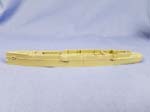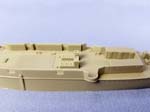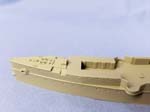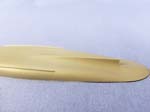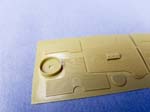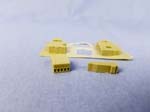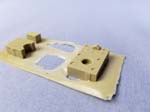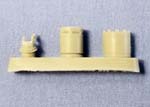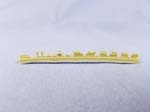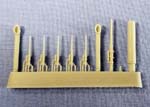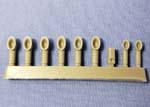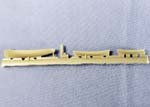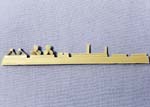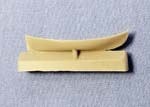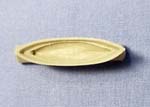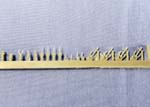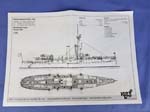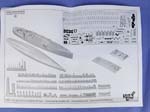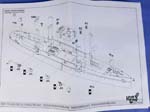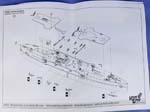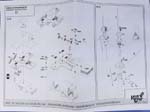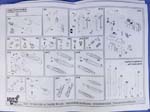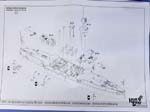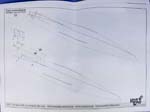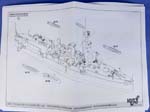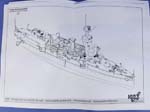| Russian
Gunboat Gilyak
Combrig Models, 1/350th Scale, Resin Reviewed by Devin Poore,
|
|||||||||||||
| The Gilyak, launched in 1898, was the
lead ship of a class of Russian gunboats . There's not a lot of her history
available on the internet in English, but through a little digging, translation
software, and asking Russian co-workers questions about various snippets
here and there, I determined that Gilyak served in the Russian home waters
most of her career, made at least one trip to the Mediterranean to show
the flag, and participated in the multi-national naval force involved in
the Boxer Rebellion. Back in home waters for the Russo-Japanese war, she
was lost at Port Arthur in 1904, the victim of either a Japanese torpedo,
field guns, or both. After abandoning Gilyak, her crew set off explosives
to destroy the ship, yet the Japanese later raised her for salvage. Note
that another Gilyak was launched in 1908 and served until 1918, something
that makes seeking out the history of a ship by this name even more challenging.
The Combrig Models 1/350th scale kit of Gilyak is marked as being the 1898 as-launched configuration. Judging by several photos on the internet, she looked a bit different at the time of her loss in 1904, but what those exact changes were, am unable to ascertain. |
|||||||||||||
| HULL | |||||||||||||
| The Gilyak's hull comes in two pieces, split at the waterline.
The resin is perfectly cast, straight, and bubble free. Casemate shielding
is thin, deck planking is well defined and straight, and small details
such as hatches, bollards, and bits are perfectly rendered. One of my pet
peeves with resin hulls has always been the need to fill and re-drill portholes,
as it seems to be impossible to keep lines of them straight. Not so here,
as all portholes are crisply rendered and in perfectly straight rows. The
lower hull is likewise blemish-free, straight and flat. A test-fitting
of the two pieces, aligning at the stern, shows how well they fit, with
only about a .5mm length discrepancy at the bow, and another .5mm offset
at midships. In both cases, the lower hull is the larger, making sanding
to blend the two parts an easy chore.
Gilyak's stated length in several sources, including the Combrig instructions is 63.09 meters. That comes out as 180.3mm in 1/350th scale. With the waterline of the kit measuring at 181mm, the size of the model is nearly spot-on. |
to enlarge |
||||||||||||
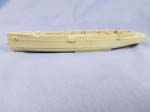 |
|||||||||||||
|
|||||||||||||
| DECKS AND DECKHOUSES | |||||||||||||
| Additional decks, besides those cast into the hull and deck houses, are flush-cast on a single extremely thin layer of resin. So thin that, as you can see in one of the photos, the parts come free simply from handling. The decks are extremely thin, .6mm according to digital calipers, which results in a little convex warpage, but with them being so slim I don't believe it'll even be necessary to heat them to straighten before assembly, as they mostly glue flush to the casemate and larger structures on the hull. Like the hull, the decks and deck houses are crisp, bubble free, and perfectly square. |
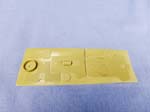 |
||||||||||||
|
|||||||||||||
| SMALL PARTS IN RESIN | |||||||||||||
| Thirteen resin runners hold the small parts of the ship, everything from guns and anchors to boat cradles and cowl vents. Again, the casting is flawless, there is no warpage, and not a single air bubble to be found. The hoods on the cowl vents go in deep enough that if one is truly dedicated to realism, I believe the body of the vent could be drilled out from the bottom to make the entire part hollow. The stack and mainmast are perfectly circular from overhead; the stack has an inset at the top, but is not hollow all the way through. Some items such as the boats and gun shields will require careful cutting to remove from the resin runners, but nothing out of the ordinary. The boat cradles and anchors are particularly fine in detail and, as with everything else, bubble and defect free. |
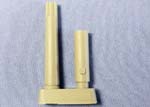 |
||||||||||||
|
|||||||||||||
| BRASS | |||||||||||||
| A 14 x 6 cm (2.5 X 5.5") sheet of brass contains the ship's railing and other fine detail. You'll find ladders, boat seats, gun shields, bow shield ornament, and other small pieces here. The majority of the sheet is a single-layer etch, but there are a few hatches and the pulleys on the davits that are relief etched. The brass is extremely thin, coming in at .2 mm, so caution is required while handling. |
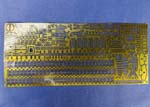 |
||||||||||||
| INSTRUCTIONS | |||||||||||||
| Instructions are on ten pages, front and back, 8.5 X 11". The first two pages cover an overall drawing of the ship and a photo of all the components, with the remaining eight pages devoted to construction. Some care will be required in finding the correct parts on the resin runners called out in the subassembly instructions, as there are no part numbers either on parts or instructions, but this is a small enough kit that it shouldn't be an issue if you take your time. One of the images on these instructions has diamater and length call-outs for mast and flag staff rods that need to be and cut from brass or styrene rod. Those six components are the only parts required that are not provided in the kit. | |||||||||||||
|
|||||||||||||
| CONCLUSIONS | |||||||||||||
I have a few quibbles with the kit, but they're not big
deals for me. One is that the brass is finer than I like to work with.
For items like the boat seats, bow decorations, and other pieces that glue
onto flat surfaces, I'm sure they'll be fine. Deck railings and davits,
however, are going to be a challenge due to their thin nature. I'll likely
go to the spares box for some thicker pieces to replace the bits requiring
a bit more strength.

My one big critique is that the kit could be packed better. Small parts, extremely tiny and fragile resin, are all lumped together in two plastic bags with nothing to protect them. It's a miracle that a gun barrel or boat davit leg didn't break during transit. It'd be so easy to stick the resin sprue runners on a cardboard backing with some double-sided tape, or sandwich the parts between thin sheets of foam. The upper and lower hull actually are delivered wrapped in thin foam, so it wouldn't be difficult to extend this protection to the rest of the parts. Those minor issues aside, this is an amazing kit. I keep mentioning how well everything is cast in this kit; bubble-free, straight, and square. Flawless. It's for a reason. I've bought and built resin kits for the past 20 years, and I can confidently say that Combrig is the state of the art in the resin casting. I've never seen a kit with such fine components cast with absolutely no errors. None. Maybe I'll find a broken part when I start building, but there is not a single air bubble or short-cast piece in the dozens of parts, from the hull down to a gun barrel. The subject matter is unique, everything except for some wire for smaller masts is in the box, and assembly should be straight forward due to the quality of the parts. Highly recommended. I can only hope that they eventually they'll do some American gunboats, such as the Yorktown and Nashville (their USS Helena is now on my "must have" list). Thank you to Combrig for the review sample. |
|||||||||||||

